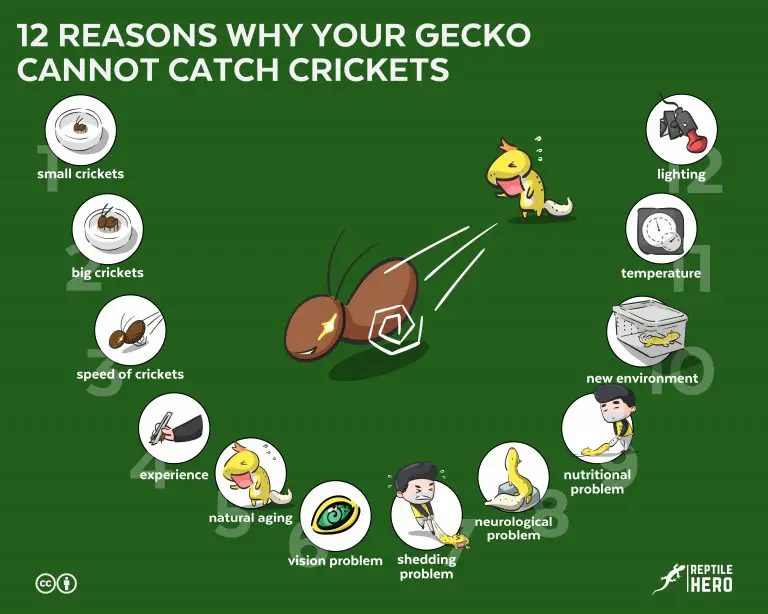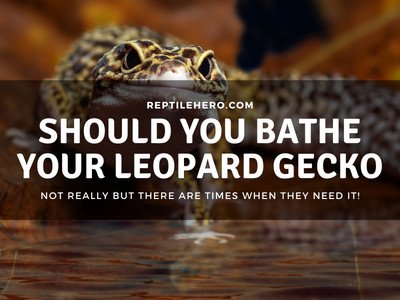7 Reasons Why Gecko Feet Are Not Sticky [and 2 Solutions]
Most geckos are known for their ability to scale walls like superheroes – much like Spiderman. However, does this superpower come with a weakness? The answer to that is yes, they do – but why exactly do some geckos experience difficulties sticking to walls and ceilings?
Geckos feet might not be sticky as unable to use van der Waals forces when they are 1) shedding, 2) have blocked setae, 3) are on slippery, 4) soft materials, 5) non-stick materials, 6) injured, or if 7) they have undergone adaptive evolution. The above can cause falling and slipping.
Stick around to know what exactly causes adhesive issues in geckos and how to deal with it!
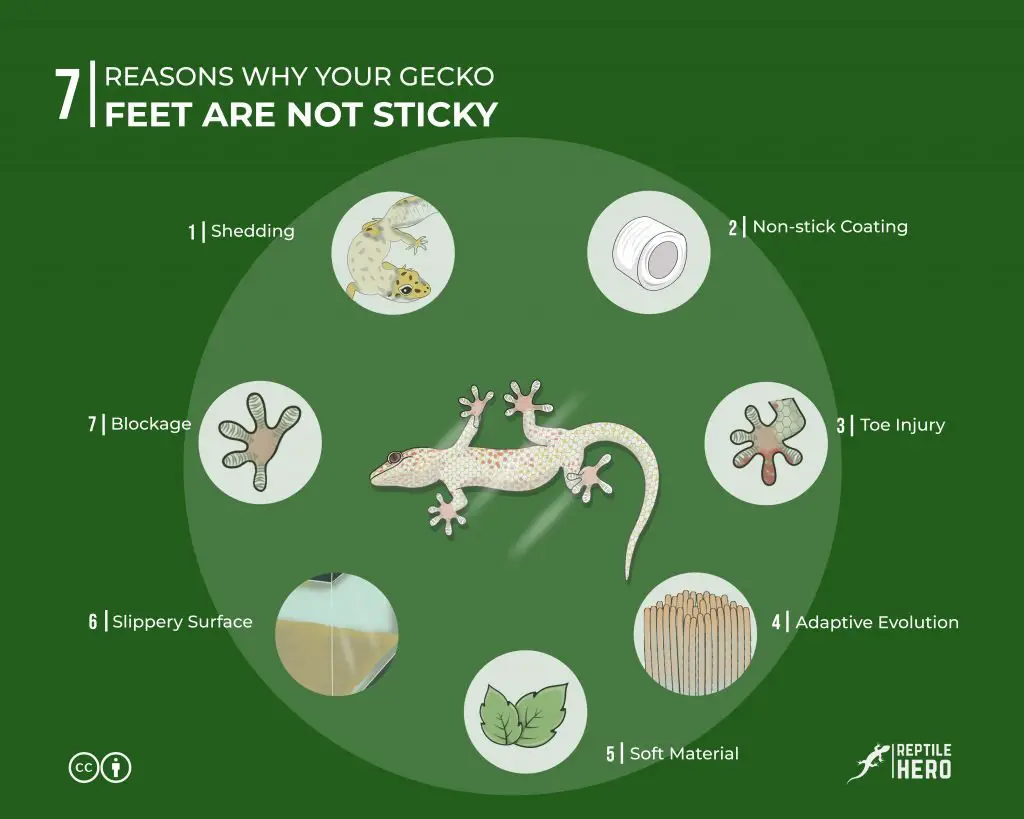
Does Your Gecko Have Sticky Feet or Not?
Although geckos don’t stick to walls the same way a strip of tape or a paper with glue does, they are still known for their gravity-defying abilities to walk on walls and ceilings with much ease and agility. However, some geckos can end up in incredibly sticky situations when their toes lose their adhesive abilities. While other geckos seem to be entirely unaffected.
Sticking and Unsticking: How do Geckos Use the Force?
Geckos use millions of minuscule spatulae at the ends of thousands of setae found at the soles of their toes. These little reptiles can pretty much stick to anything! They do so with the help of the force – an intermolecular kind referred to as van der Waals force. Since I’ve already discussed this at great length in a previous article, I’m just going to give you a quick recap.
Think back to your high school science class. You probably remember learning about atoms, the building block of basically every single thing in the whole universe. You might also recall that these are made up of electrons and a nucleus containing protons and neutrons.
Due to the available spaces in between electrons, the positive and negative charges within the nucleus of a single atom are exposed to other atoms around it, attracting the negative and positive sides of each other. Multiple atoms form molecules that also possess positive and negative charges. That’s how the toes of geckos “stick” to a multitude of things and travel across the world in a way that seems to defy gravity. Here is a short animation to help you visualize all of this:
These fascinating creatures are also capable of readily detaching themselves whenever needed, to either catch prey or evade a predator. By simply curling up their toes to the extent where their setae are at an angle of about 30° they disrupt the force of attraction between their setae and the ground, wall, or ceiling [1].
Most geckos can quickly attach and detach themselves from any surface or material by adjusting the angle by which their setae is resting against it. Hence, they only need to move their toes to a certain degree to either facilitate or hinder van der Waals forces.
Unfortunately, many geckos may slip or fall through no fault of their own, when they have no intention of detaching. They could lose the stickiness in their feet for different reasons.
7 Reasons Why Your Gecko’s Feet Do Not Stick
As I’ve said, the majority of geckos need their sticky feet to thrive in any environment – be it the wilderness or captivity. However, their sticky feet don’t always work the way they want and need them to. Still, other geckos appear as though they have no need for it whatsoever. Regardless of its usefulness for our geckos, let’s find out why geckos have feet that aren’t sticky.
#1 – Shedding
Shedding is probably the most common reason why geckos experience sticking trouble. Plus, seeing as shedding is a regular and natural process geckos and most other reptiles go through, it’s not much of a cause for worry.
Because the loosened dry skin is still wrapped around their bodies including their itty bitty toes, the thin layer blocks their setae from directly interacting with and sticking to other objects. Taking this into consideration, it’s easy to see why they may have trouble climbing and walking on incredibly steep surfaces during this time.
The normal process of shedding in geckos causes dry skin to blanket their whole bodies for a short period of time. This hinders van der Waals forces. After the old skin has completely been shed and eaten, geckos regain their ability to stick to things.
It is, however, significant to note that geckos who are dehydrated, fed a diet deficient in vitamin A, or kept in an environment that does not meet their needs for humidity, will experience issues when trying to shed.
Dysecdysis, or the abnormal shedding of dead skin, could pose more serious problems in geckos. They may not only lose their adhesive abilities but also lose their toes and limbs completely from the loss of blood circulation and tightening build-up of unshed layers of old dry skin.
#2 – Blockage
If you have a gecko that’s a messy eater, especially one that likes to walk all over its live feeders while hunting, or on a that just likes to put a foot or two into its feeding dish for no reason you can understand, the little guy (or girl) in your care would most probably have food stuck on its toes.
Most of the time, it can be hard to see. That is unless you thoroughly monitor and regularly handle them. Doing so will actually make it easier for you to tell when there’s a blockage in their toes. The unusual texture of their feet, once they start walking on your hand and arm, is a dead giveaway. Moreover, even the smallest and finest specks of supplement powder, dust, dirt, or loose substrate can block the setae on gecko feet.
When minute pieces of food, powders, dust, dirt, and/or substrate are present in great quantities within your gecko’s enclosure, they will likely attach themselves to the setae in your gecko’s toes. As their setae have already been blocked, they will no longer have the capacity to utilize van der Waals forces to run and stay in areas perpendicular to the ground.
For frugivorous geckos which are given honey as a treat and fed with a commercial diet that needs to be mixed with water, this problem occurs more frequently. Walking around their tanks after their meals, their wet toes accumulate dirt and the like much faster. Similarly, even if a gecko has clean feet, it will still have great difficulty holding onto surfaces that are covered in dirt and mineral build-up.
Since small particles (e.g., dirt) are more readily available for bonding compared to a big and solid material (e.g., glass panel), the setae will more likely attach to the relatively free particles.
#3 – Slippery Surface
Some people say that low humidity directly causes issues with the sticky toe pads of geckos failing. However, it actually only indirectly causes such problems when geckos are kept in tanks with extremely low levels of humidity – little to no moisture whatsoever – which results in dehydration.
However, the opposite is just as detrimental for the ability of geckos to stick to walls and ceilings. In fact, when geckos are forced to scale slippery surfaces, the ability of their hairy toes to stick to any material is greatly compromised.
Numerous researchers have found that geckos can’t maintain a strong adhesive hold onto any material once their feet and/or the surface they are on is soaked or misted with water [2, 3]. As you can see in the video below, their ability to run along walls with great agility – even on an incredibly hardy and smooth material – is greatly affected when it is too moist.
The ability of all the gecko’s setae to utilize van der Waals forces to keep moving or stay glued onto a clean and solid but wet surface that’s inclined at an angle of (more or less) 90° is greatly impaired. The layer of water between the setae and surface prevents them from successfully forming an attractive bond with each other.
This could also explain why geckos may have trouble climbing up any surface that has been covered with any other liquid regardless of viscosity – oil, honey, etc.
#4 – Soft Material
In the wild, geckos have been documented scurrying around a wide variety of surfaces – waxy and soft leaves, rough and hard rocks and trees, name it and they’ve probably climbed it. Surprisingly, though, a few studies have also shown that geckos experience a tougher time trying to hold onto soft, thin materials on an incline [3].
The normal adhesive abilities of gecko setae are reduced by 50% when trying to form van der Waals forces with soft, pliable, and thin materials that are placed perpendicular to the ground.
The exact mechanisms and variables affecting this case are not yet fully understood even by scientists. However, some do say that it may not simply be the softness of the material that prevents proper adhesion.
Personally, I think that the most obvious reason could be that the flimsiness of any soft and thin material would prevent gecko setae from maintaining the proper angle needed for them to stay glued to the surface without slipping or falling off. Because such items are extremely pliant, the slightest twist could cause setae to lose their grip.
#5 – Non-stick Coating
Aside from wet surfaces, geckos also have trouble walking normally on inclined surfaces that have been treated to become non-stick. The name says it all, quite honestly.
Polytetrafluoroethylene (PTFE), more commonly known as Teflon, is a plastic material often used to coat several different cookware and utensils to make them non-stick [4]. But what exactly makes it resistant to sticking? Well, it’s actually quite simple.
The fluorine atoms present in the outermost layer of Teflon repel virtually any other material. As a result, no material can adhere to an item coated with PTFE. Non-stick coatings lack both negative and positive charges needed by gecko setae to induce van der Waals forces.
If you still find it hard to believe, watch this:
You may have noticed the incredibly small ridges present on the bottom of the Teflon pan. That’s basically the only thing allowing this small gecko to get a grip despite having the pan held in a steep incline. If it was a totally smooth Teflon pan, the gecko inside would’ve been sliding to and fro as the man holding it was tilting the pan from side to side – just like a nice sunny side up egg you’re frying for breakfast.
#6 – Toe Injury
Many years ago, I heard a story about one rescued crested gecko. The keeper who got her was mortified by the way the store was keeping them. Tons of cresties were housed together in a single tank. Bear in mind, they were of different sizes, ages, and sexes!
In such a set-up, these creatures were bound to act quite aggressively towards one another. Sadly, many of them lost toes from intense scuffles with each other. These precious little cresties were visibly having a hard time getting around their enclosure due to the limited space and their diminished ability to stick onto things.
To add to this, the build-up of unshed skin in the toes of our geckos could also result in its necrosis if not treated properly and on time. This makes it difficult for them to move about as they would normally. Note that there’s also the risk of infection.
Geckos that have lost toes and limbs from injury or illness are more likely to fall and slip due to significant loss in the total number of setae.
Some hobbyists have also claimed that geckos who lose the stickiness of their feet may be displaying an early sign of metabolic bone disorder (MBD) or some form of neurological disorder like Enigma syndrome (ES).
However, I’d say that them not being able to run up vertical and steep surfaces with ease is more likely due to the overall weakness as well as issues with maintaining balance instead. In other words, it’s probably not because their sticky feet lost their adhesive powers in one go – it’s just that they don’t have the strength to do so.
#7 – Adaptive Evolution
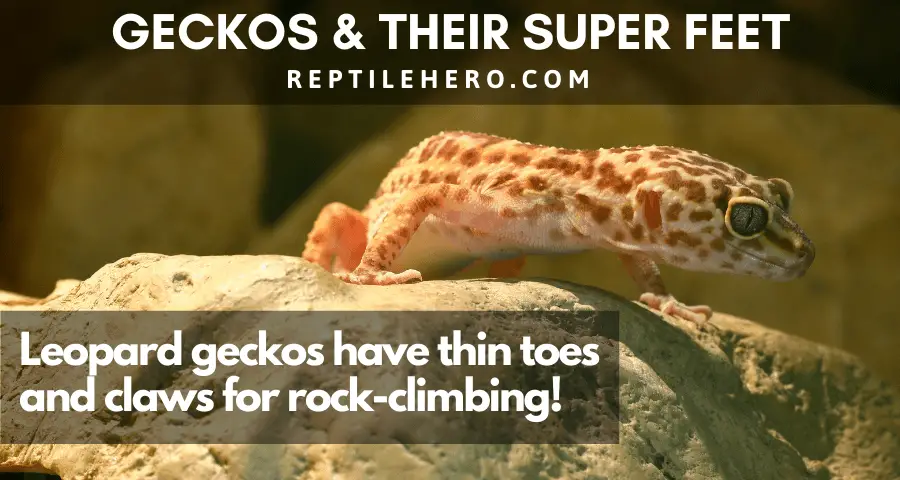
Observe how an arboreal gecko moves about while on the substrate of its vivarium. You will probably see how they curl up their toes when walking or running forward. In the wild, this could be a matter of life and death for them if there is no tall tree to climb onto for escape. Since they have to continuously engage and disengage their setae or keep their toes curled up while running on relatively flat ground, they run the risk of getting caught by predators.
However, not all geckos have sticky feet. Arboreal geckos normally have sticky toes to climb canopies. Terrestrial geckos, on the other hand, stay mostly on the ground, at times even burrowing into the substrate for shelter and feeding. As their setae lost functionality through the ages, some terrestrial geckos have completely lost all the setae in their toes.
As a matter of fact, only 60% of all gecko species have sticky feet [5]. This is only one of the many differences between crested and leopard geckos – cresties have sticky feet but leos do not. This loss may seem like a great disadvantage, however, this actually makes life much easier and safer for ground-dwelling geckos [6].
Due to the absence of setae in their toes that normally brings about van der Waal forces, terrestrial species like leopard geckos can run across flat surfaces much faster as well as scale rock formations and burrow into the ground using their claws.
Certain species have also developed other special features in addition to losing their setae. For example, some geckos have developed stubbier toes to aid digging while others developed longer feet to allow them to move much faster.
2 Ways to Make Your Gecko’s Feet Sticky Again
For humans, having sticky fingers is something frowned upon as it is a bad tendency to have. In stark contrast, for geckos, having sticky toes is something incredibly useful as it could ensure their survival.
So if your little friend is having trouble sticking to walls, vines, and plants like usual due to accumulated dirt, substrate, and/or food in their amazing but small toes, you can easily help them!
There are two main methods keepers use to help their geckos regain the adhesive quality of their feet:
- Help your gecko take a bath. Find a clean plastic container that is big enough to comfortably temporarily house your gecko – a deli cup or old but clean dish will do. Fill it with room temperature water (approximately 73°F or 23°C) until the water level is right under your gecko’s belly – this is to ensure that your gecko doesn’t drown. There is no need to cover the bathing container, just keep your eyes on your gecko while it’s bathing (it may try to jump out of your make-shift bathtub). Let them soak in there for 5 to 15 minutes.
- Let your gecko go for a sauna. Find a clean plastic container that is big enough to comfortably temporarily house your gecko, solder a few holes on all sides near the opening. You could also use a small clean critter keeper (here on Amazon) if you don’t want to go through all that hassle. Then place a wet layer of paper towel on the bottom. Use room temperature water for this as well. Once your gecko is comfortable inside, close the lid and let it stay there for 15 to 30 minutes.
If they lost their feet’s stickiness due to retained shedding, you can help them get rid of the skin by gently rubbing it off with a cotton swab. Never peel it off forcefully. Also, room temperature may seem cold but what’s just warm to us could feel insanely hot for geckos because they are ectothermic animals.
The Consequence of Losing Sticky Feet for Geckos
In the wild, losing the adhesive ability of their toes could prove fatal. They may fall from great heights and sustain severe injuries or even die. But in captivity, such risks are minimal and could easily be prevented.
Sure, they can still fall and slip from time to time, however, if they’re behaving like they normally would – eating well, pooping regularly, still being active – there’s not much cause for concern.
In the event that they do start behaving differently after landing on a hard and jagged or sharp surface after a fall or slip (even at relatively low heights), call your vet and schedule a visit immediately.
6 Practical Tips to Prevent Gecko from Falling or Slipping
There are many ways to prevent your gecko – both arboreal and terrestrial – from falling and slipping all over the place and possibly hurting themselves because they don’t have sticky feet.
- Humidity: Set-up a dedicated humid hide in their enclosure so they can shed without any problems.
- Multivitamin: Give them not only calcium powder but supplements with vitamin A and many other vitamins and minerals (here and here on Amazon) as well so they are healthy and shed properly.
- Hydration: Make sure they stay hydrated with regular misting or a shallow water feature for drinking and soaking. Read this for more details on water and hydration for geckos.
- Enclosure: Furnish their enclosures in a way that mimics their natural environment, with rough and textures barks and rocks for removing dead skin.
- Clean: Slean their tanks, especially glass sidings, regularly. It doesn’t always have to be deep clean, just make sure the surfaces they climb onto aren’t too dirty and the glass doesn’t have too much mineral build-up.
- Decor: Placing vines, plants, and rock steps or formations also provide for safer exploration compared to a bare tank with only a hide or two and a feeding bowl.
Takeaways
Geckos are unable to use van der Waals forces to stick onto vertical surfaces mostly when they are still in the process of shedding old skin, have things stuck in their setae, or are injured or ill. Surfaces that are slippery, soft, or coated in polytetrafluoroethylene also impede the adhesive abilities of gecko setae. Lastly, some geckos have totally lost setae due to adaptive evolution.
For geckos with dirty feet and stuck shed skin, giving them a bath or a sauna could help them bring back the stickiness of their toes.
Falling and slipping from vertical surfaces could be fatal for wild geckos. For geckos kept in the care of humans, the risks are minimal and could easily be prevented.
Sources
[1] https://www.nature.com/articles/35015073
[2] https://jeb.biologists.org/content/jexbio/215/17/3080.full.pdf
[3] https://www.pnas.org/content/110/16/6340
[4] https://www.scientificamerican.com/article/if-nothing-sticks-to-tefl
[5] https://www.calacademy.org/explore-science/the-evolution-of-sticky-feet
[6] https://www.latimes.com/science/sciencenow/la-sci-sn-gecko-feet-evolution-walk-20150102-story.html

![Deep Heat Projectors For Leopard Geckos? [Final Guide]](https://www.reptilehero.com/wp-content/uploads/2021/08/gecko-deep-heat-projector-small-cover-infographic.jpg)
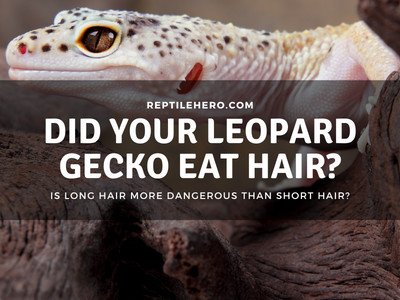
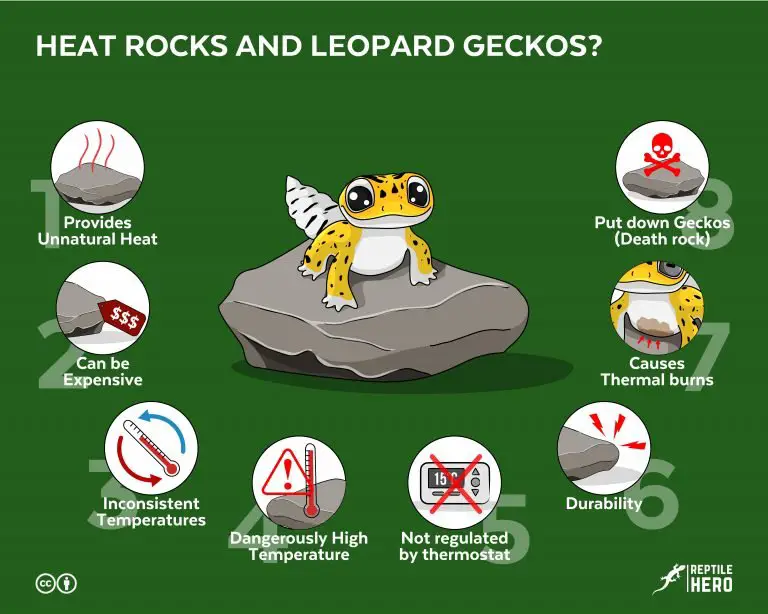
![Choose the Right Thermostat for Your Gecko Tank [7 Factors]](https://www.reptilehero.com/wp-content/uploads/2021/09/choose-gecko-tank-thermostat-small-cover-infographic.jpg)
